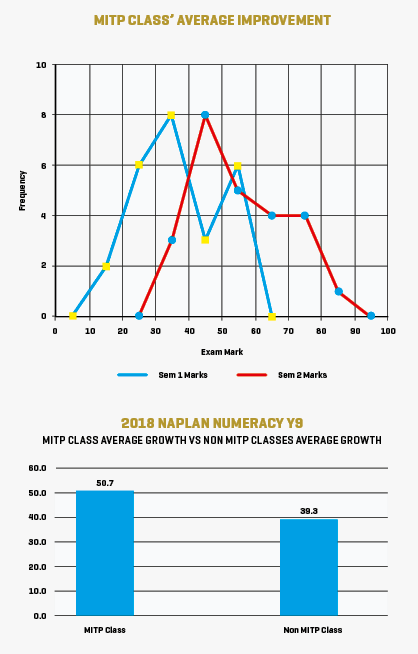Do the math
Greg Cheetham discusses the need for students to sharpen up on their level of mathematics and shares details of a program that is paving the way to ensure it happens.
Almost 50% of students seeking an apprenticeship in the building and construction industry were rejected due to their level of mathematics according to the Apprenticeship Engagement Forum (AEF).

With nearly 30 years in vocational education, 20 of which were at the coalface, I can testify that one of the biggest barriers to apprentices and trainees completing their qualifications is their ability to do the maths. This has been well recognised for many years with multiple taskforces and committees established at national, state and even local levels to try and find solutions.
The AEF is contracted by the Training Services NSW to be an advocate for the construction industry on training matters and encourage the uptake of construction apprenticeships to meet the industries skill needs into the future.
According to the AEF, almost 50% of students seeking an apprenticeship in the building and construction industry were rejected due to their level of mathematics. Andrew realised early on that the key to improving completions in construction trade qualifications would be found in secondary schools where the fundamental principles of mathematics are laid.
To help address the maths issue, CEO of the AEF Andrew Bryson enlisted the support of Master Builders Association (NSW), Master Plumbers (NSW), Housing Industry Association (NSW) and the principals of four high schools.
The first step in addressing the problem was to get the members to engage with the secondary schools, students and parents at high school subject selection nights and provide up-to-date information on building and construction apprenticeship opportunities.
AEF members regularly encountered resistance from students when discussing the need for them to select maths as a subject. That was the spark that ignited the development of the Mathematics in Trades Pathway (MITP) based on the current mathematics curriculum using experiential learning concepts.
MITP does not replace the current Stage 5 mathematics outcomes, but simply repackages it in a practical and engaging way to support students pursuing an apprenticeship or traineeship as their first career option.
It aims to:
- Ensure students can achieve workplace numeracy requirements and the necessary stage 5 and 6 outcomes through the Mathematics in Trades Pathway.
- Support students to ensure they are confident, capable and successful apprentices with proficient and practical numeracy skills.
As an example, students may be asked to design, cost and finally build a landscape project. The project involves making a scaled drawing, calculating areas and volumes for soil and spoil and calculating material quantities and costs for timber, bricks, sand, cement and plants and irrigation supplies. They have to visit a hardware store and contact suppliers to get prices and order materials. Then they build it. This is only an example, I’m sure you could think of many others that would suit a high school learning environment.
In 2017 a trial of the MITP was set up in a small number of high schools in the western suburbs of Sydney involving year 9 students.
Rooty Hill high school deputy principal and head teacher mathematics and past president of the Mathematical Association of NSW John Meng joined the AEF and is responsible for the development of MITP.

John Meng.
He led a team of like-minded high school mathematics teachers to collaborate on the design, implementation and evaluation cycle of MITP in 2018. Today MITP programs and resources are shared in the public domain with teachers from across three school sectors in NSW and beyond.
“It was not an easy step to take, but so far, the underpinning theory of MITP is well accepted by the teachers. But, some concerns were raised. It would be challenging to teach mathematical concepts and skills in ’trade’ context… and to meet the strict safety requirements when MITP students are attempting practical work,” says John.
To overcome the barriers the team designed and delivered multiple professional development workshops for MITP teachers with a special focus on co-plan and team teach practical lessons with qualified TAS/VET teachers to avoid the anxiety and risks caused by teaching ‘out-of-field’. At the moment (early 2019), there are about 50 students in the MITP across two schools in the area. But it is expected there will be many times that number across NSW by year’s end.
There are similarities between STEM and MITP approaches to motivate and engage learners, but MITP applies mathematics in a ’trade’ context, e.g. calculate the pitch and rafter length in a gable roof.
Another distinct feature of MITP is the extensive use of assessment strategies to assess students’ knowledge and skills through teacher observation and professional judgment. The ‘Project Based Assessment’ approach has the advantage of better reflecting their mathematics learning achievements.
The results from the first groups were analysed in 2018 with what I think are remarkable results. For many participants it was their first real engagement with maths in this way.
The trial showed a marked improvement with reduction of E grades, with 5 students achieving top grades at the end of semester 2.
The 2018 NAPLAN showed MITP class’ average improvement exceeded other Year 9 classes by 29%.

What was even more exciting was a 66% (2018 MITP students) reduction in the number of school suspensions given to students in MITP, significantly reduced from 13 in 2016 (No MITP program) and then 11 in 2017 (first year MITP was run) to just 4 in 2018. The trial unmistakably demonstrated greater student participation and success in mathematics.
Following on from the successful trial, over 20 high schools have signed on to introduce the MITP program in 2019. The trial has expanded to include years 10 and 11 with a year 12 MITP trial planned for 2020.
The first full graduates of the MITP will be announced by the end of 2021 by which stage ut is hoped 200-plus schools will adopt it as teaching model.
As part of ongoing research, each student in a Trade Readiness or VETiS course is given a Unique Student Identifier number (USI). The USI is used to track and record training and qualifications gained through any recognised training organisation (RTO). This way they will be able to track through to completion any student that goes into an apprenticeship.
Other states and territories are watching the progress of the trials and developing project based and experiential learning models for their students.
John Meng believes the key to ongoing success for the MITP is to work to engage industry with schools and teachers to make the benefits of a career in building and construction known to students and help unpack the literacy, numeracy and interpersonal skills that a successful apprentice must develop.

Andrew Bryson
If you’re a teacher, trainer or concerned parent of a secondary student/s and think your students, sons or daughters could benefit from this approach, contact Andrew Bryson from the Apprenticeship Engagement Forum via www.apprenticeshipengagementforum.com.au.
Or simply forward this article onto your local high school and encourage them to make contact.
